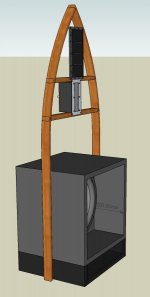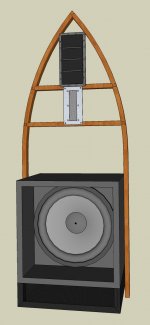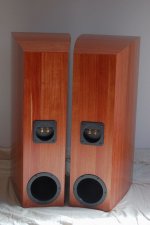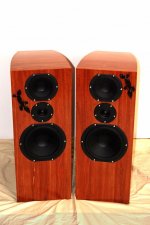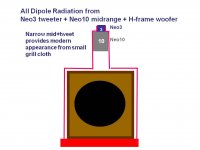More Doodling
I have added a section at the bottom, to house the amps etc, moved the frame back to align the speakers. I have also made the gothic frame wider & could have rubberised mounts on the sides for some isolation & of course Iv'e thrown in a Neo10 for good luck.
I'm not over the moon about the design, just a place to start.
If there's anything wrong with the concept please feel free to tell me
David
I have added a section at the bottom, to house the amps etc, moved the frame back to align the speakers. I have also made the gothic frame wider & could have rubberised mounts on the sides for some isolation & of course Iv'e thrown in a Neo10 for good luck.
I'm not over the moon about the design, just a place to start.
If there's anything wrong with the concept please feel free to tell me
David
Attachments
An externally hosted image should be here but it was not working when we last tested it.
Hello
My name is Veera firt time i have member diy audio. My job make speaker box. I have owner shop in thailand for make speaker box.
This picture i make my self. If are you have need speaker box. Please contrac
to me at e-mail-address: suwanamoo@yahoo.com
With that driver choise it can become the best there is. DavidI have added a section at the bottom, to house the amps etc, moved the frame back to align the speakers. I have also made the gothic frame wider & could have rubberised mounts on the sides for some isolation & of course Iv'e thrown in a Neo10 for good luck.
I'm not over the moon about the design, just a place to start.
If there's anything wrong with the concept please feel free to tell me
David
To prefend any boxie sound I would use a small baffle maybe with some side panels on the back side. That is a thing to explore what work best.
I am curious how this project ends🙂
Last edited:
David,
in view of best stability you better have some mass (amps etc.) fixed to the top of the H frame instead of below. I see that this would make the distance between woofer and midrange larger - but why would you place the mid driver on top of the tweeter in the first place?
Rudolf
in view of best stability you better have some mass (amps etc.) fixed to the top of the H frame instead of below. I see that this would make the distance between woofer and midrange larger - but why would you place the mid driver on top of the tweeter in the first place?
Rudolf
Hi David,
nice and cool desing there ! Certainly unique those gothic curch windows.
I also considered integrating the electronics into the speaker either on top or at the sides. But I departed from the idea again because I did not want the strong magnets affect the circuits. Not sure if they would, though.
Oliver
nice and cool desing there ! Certainly unique those gothic curch windows.
I also considered integrating the electronics into the speaker either on top or at the sides. But I departed from the idea again because I did not want the strong magnets affect the circuits. Not sure if they would, though.
Oliver
David,
in view of best stability you better have some mass (amps etc.) fixed to the top of the H frame instead of below. I see that this would make the distance between woofer and midrange larger - but why would you place the mid driver on top of the tweeter in the first place?
Rudolf
"but why would you place the mid driver on top of the tweeter in the first place?"
It is the same as they layout I have now, which is a direct copy of Lukasz Frikus P17 OB, I'll have to admit I do not know or have forgottten the theory behind the speaker placement. It is also the same as a set of box speakers that I made son my son, under the guidance of a local speaker manufacturer, my son & his mates think they sound great, although a little lacking in bass, imagine that! sorry about the right hand photo, most of the good ones are too large to load.
Having said that I cannot determine any fault when listerning to them, maybe thats because I'm a beginner.
Attachments
Hi David,
nice and cool desing there ! Certainly unique those gothic curch windows.
I also considered integrating the electronics into the speaker either on top or at the sides. But I departed from the idea again because I did not want the strong magnets affect the circuits. Not sure if they would, though.
Oliver
I was thinking I might need some type of shielding, but I'm not sure you can shield for magnetic field.
David
Hi DQ828,
Most dipole experts use a dipole tweeter. The modest cost Neo3 is popular. Although the RAAL 140-150 ribbon would be superior in a sealed box, the Neo3 would integrate better in a dipole design. RAAL now makes a dipole ribbon tweeter, but it is expensive and I have not seen any reviews. You may want to experiment with a Neo3 before purchasing or making a dipole ribbon tweeter.
A smaller, simplier top frame for the mid+tweet would have a more modern appearance, especially with a grill cloth like a nylon stocking.
Most dipole experts use a dipole tweeter. The modest cost Neo3 is popular. Although the RAAL 140-150 ribbon would be superior in a sealed box, the Neo3 would integrate better in a dipole design. RAAL now makes a dipole ribbon tweeter, but it is expensive and I have not seen any reviews. You may want to experiment with a Neo3 before purchasing or making a dipole ribbon tweeter.
A smaller, simplier top frame for the mid+tweet would have a more modern appearance, especially with a grill cloth like a nylon stocking.
Attachments
I just been agonizing over wether I should buy the Neo10 & Neo3 on the BG, Neo10 - n10 by: BG Radia - Meniscus Audio Group, Inc.| Speaker website, only to read
"Please note that these are restricted to sales within North America Only"😱
what the!!
"Please note that these are restricted to sales within North America Only"😱
what the!!
Lukasz doesn't tell on his website, why he did the "Endorphine" like he did. He just says "trust me" 🙄"but why would you place the mid driver on top of the tweeter in the first place?"
It is the same as they layout I have now, which is a direct copy of Lukasz Frikus P17 OB, I'll have to admit I do not know or have forgottten the theory behind the speaker placement. It is also the same as a set of box speakers that I made son my son ...
What he does not tell you: Most anybody else would recommend that the CC distance between woofer and midrange driver should not exceed 1/2 wavelength of the crossover frequency. Your sons box follows that rule for sure, so no problem with that. But then it does not place the woofer on the floor and the tweeter at 1 m like Lukasz does.
Having said that I cannot determine any fault when listerning to them, maybe thats because I'm a beginner.
Most loudspeakers sound nice until you have heard better ones. 😉
Regarding magnetic shielding: In radio, hifi or PA-systems with built-in loudspeakers nobody has ever protected the electronic circuits from magnetic fields. Only the electrons moving in the vacuum of the CRT had been affected. If there is anything to worry about placing amps on top of a loudspeaker, it would be the transfer of mechanical vibrations.
Rudolf
Well I have abandoned the Raal's for the moment, as it is not a dipole & the Dipole version they have just released is way too expensive.
I am going to buy the BG Neo10 & Neo3 and run them side by side with my Saba mids & tweeters, to compare them.
I am just learning how to use the ABC dipole spreadsheet & will use that to work out the most approapiate H frame size for my new Dipole15's. Once I have settled on a H frame size I will make a couple of test boxes, then try the various mids & tweeters NUDE & then with the ABC recommended baffle size. I will do lots of measuring during the process.
After all that and much listerning I will finalise the design, wether it be NUDE or with a baffle, and make some fancy speakers.
Of course I have to get the active side of things going as well. I have decided to buy the MiniDSP & run it thru my reciever for the moment. Once all of the speaker design work has been finalised & construction is underway. I will research & build amps that I can install into the bass cabinets.
I only hope I live long enough to get it all finished, no I dont have a terminal disease but I can see it may a take awhile. Lot's of fun to be had on the way.
David
Thanks for your patience & assistance
I am going to buy the BG Neo10 & Neo3 and run them side by side with my Saba mids & tweeters, to compare them.
I am just learning how to use the ABC dipole spreadsheet & will use that to work out the most approapiate H frame size for my new Dipole15's. Once I have settled on a H frame size I will make a couple of test boxes, then try the various mids & tweeters NUDE & then with the ABC recommended baffle size. I will do lots of measuring during the process.
After all that and much listerning I will finalise the design, wether it be NUDE or with a baffle, and make some fancy speakers.
Of course I have to get the active side of things going as well. I have decided to buy the MiniDSP & run it thru my reciever for the moment. Once all of the speaker design work has been finalised & construction is underway. I will research & build amps that I can install into the bass cabinets.
I only hope I live long enough to get it all finished, no I dont have a terminal disease but I can see it may a take awhile. Lot's of fun to be had on the way.
David
Thanks for your patience & assistance
David it is quit challenging what you want to do.
Explore :
measuring.
Active filtering.
And design a OB 3way where everything fits right.
I wish you courage during the build.
Regards Helmuth
Explore :
measuring.
Active filtering.
And design a OB 3way where everything fits right.
I wish you courage during the build.
Regards Helmuth
Mid Driver Baffle step
Another thing I'm having trouble getting my brain around is, a lot of the baffle-H frame-U frame design is based around moving the baffle step above the crossover frequency, which obviously solves the baffle step problem for the bass driver, but then the mid driver will have the baffle step problem.
So whats the advantage, in handing the problem over to the mid driver?
I feel like I'm asking another stupid question, 😕but what the hey that has never stopped me in the past.
David
Another thing I'm having trouble getting my brain around is, a lot of the baffle-H frame-U frame design is based around moving the baffle step above the crossover frequency, which obviously solves the baffle step problem for the bass driver, but then the mid driver will have the baffle step problem.
So whats the advantage, in handing the problem over to the mid driver?
I feel like I'm asking another stupid question, 😕but what the hey that has never stopped me in the past.
David
First measure the output of your system.Another thing I'm having trouble getting my brain around is, a lot of the baffle-H frame-U frame design is based around moving the baffle step above the crossover frequency, which obviously solves the baffle step problem for the bass driver, but then the mid driver will have the baffle step problem.
So whats the advantage, in handing the problem over to the mid driver?
I feel like I'm asking another stupid question, 😕but what the hey that has never stopped me in the past.
David
I never used a dsp but for what I know it can compensate a baffle-step easy. No problemo
I would agree with Helmuth that, at least in the digital domain, these frequency boosts related to the baffle dimensions are relatively easy to compensate.
When you design your H-Frame or U-Frame such that the dipole frequency is above the crossover frequency for the woofer you eliminate the problem in that range. This doesn't mean that you are _moving_ the problem to the midrange as they will likely have a bump in the response around the dipole baffle size of the midrange baffle regardless. (not likely the same size as your U or H-Frame). So considering that your baffle for the midrange is likely much smaller than the U-H-Frame baffle for the woofer and so you will likely have an additional dipole frequency response bump to contend with for that dimension.
The smaller you make your baffle the more likely it is that you can avoid operating in the dipole boost range but this comes with something of a trade-off in efficiency. (Have a look at Stig Erik's nude build... my understanding is that he operates most all of his drivers below the dipole frequency.) Building a dipole like JohnK's NaNote it would appear that he has followed a similar minimal baffle trend to minimize the negative effects of baffle boost. It is important to understand that the minimal baffle idea is a tradeoff and so you should also consider the positive effects of the baffle..... i.e better extension at lower frequencies.
In my own build, I did not place the midrange drivers in the same location (i.e. not both at the exact center of the baffle) so the boost at dipole baffle size should theoretically be less obtuse. Of course this was also tradeoff and others may advise against my direction.
Linkwitz has written much more eloquently on the topics of baffle step (diffraction).
Diffraction from baffle edges
as well as equalization of a dipole woofer
Dipole Woofer equalization
I hope this helps.
When you design your H-Frame or U-Frame such that the dipole frequency is above the crossover frequency for the woofer you eliminate the problem in that range. This doesn't mean that you are _moving_ the problem to the midrange as they will likely have a bump in the response around the dipole baffle size of the midrange baffle regardless. (not likely the same size as your U or H-Frame). So considering that your baffle for the midrange is likely much smaller than the U-H-Frame baffle for the woofer and so you will likely have an additional dipole frequency response bump to contend with for that dimension.
The smaller you make your baffle the more likely it is that you can avoid operating in the dipole boost range but this comes with something of a trade-off in efficiency. (Have a look at Stig Erik's nude build... my understanding is that he operates most all of his drivers below the dipole frequency.) Building a dipole like JohnK's NaNote it would appear that he has followed a similar minimal baffle trend to minimize the negative effects of baffle boost. It is important to understand that the minimal baffle idea is a tradeoff and so you should also consider the positive effects of the baffle..... i.e better extension at lower frequencies.
In my own build, I did not place the midrange drivers in the same location (i.e. not both at the exact center of the baffle) so the boost at dipole baffle size should theoretically be less obtuse. Of course this was also tradeoff and others may advise against my direction.
Linkwitz has written much more eloquently on the topics of baffle step (diffraction).
Diffraction from baffle edges
as well as equalization of a dipole woofer
Dipole Woofer equalization
I hope this helps.
Last edited:
Hy Open Baffle fans!
I have an important question! I would like to build an OB speaker. I have everything for this project...modded DSP based active crossover (DCX2496), and 8 channels class D amps....
My question:
Bass driver configuration:
1X15"= 860 cm2
2X12"= 1100 cm2
4x8"= 880 cm2
This variations can give similar results in low frequency response? I would like build this OB speaker with more smaller driver (4X8" / panel), because i have special budget price for this Hivi speakers.
Product information:BG8N Bass-Midrange
If you think not enought the area of the four bass driver / side, I can build this project eight 8" driver / side.....
Thanks!
I have an important question! I would like to build an OB speaker. I have everything for this project...modded DSP based active crossover (DCX2496), and 8 channels class D amps....
My question:
Bass driver configuration:
1X15"= 860 cm2
2X12"= 1100 cm2
4x8"= 880 cm2
This variations can give similar results in low frequency response? I would like build this OB speaker with more smaller driver (4X8" / panel), because i have special budget price for this Hivi speakers.
Product information:BG8N Bass-Midrange
If you think not enought the area of the four bass driver / side, I can build this project eight 8" driver / side.....
Thanks!
Hy Open Baffle fans!
I have an important question! I would like to build an OB speaker. I have everything for this project...modded DSP based active crossover (DCX2496), and 8 channels class D amps....
My question:
Bass driver configuration:
1X15"= 860 cm2
2X12"= 1100 cm2
4x8"= 880 cm2
This variations can give similar results in low frequency response? I would like build this OB speaker with more smaller driver (4X8" / panel), because i have special budget price for this Hivi speakers.
Product information:BG8N Bass-Midrange
If you think not enought the area of the four bass driver / side, I can build this project eight 8" driver / side.....
Thanks!
Hi Kalmi79
I still have my training wheels on but from what Iv'e learnt during this thread it hard to go past 1x15, the best way to improve on 1x15 is of course 2x15 or 1x18😀
I originally wanted to to use 2x10 or 2x12 but the performance of the AE 1x15Dipole was hard to beat & of course I only had to buy & ship 2 drivers. If I had the money to throw around I would buy the drivers & build the design thats at the start of this thread & if it didn't work so be it, but I dont have that sort of money to take the chance on. So I'm playing it safe with the 1x15, which arnt cheap either.
I dont believe you will get the lower frequency's no matter how many 8" you use. you will get the SPL though, to get low go big or go sub.
I like the look of the drivers, they have a low Qts which is not recommended but I guess if you are using DSP you may be able to get around that.
I'm also not sure it's a great idea to design a speaker around drivers base on the fact that you can get them cheaply🙂 A bargins always hard to turn up though.
David
Last edited:
Hy Open Baffle fans!
I have an important question! I would like to build an OB speaker. I have everything for this project...modded DSP based active crossover (DCX2496), and 8 channels class D amps....
My question:
Bass driver configuration:
1X15"= 860 cm2
2X12"= 1100 cm2
4x8"= 880 cm2
This variations can give similar results in low frequency response? I would like build this OB speaker with more smaller driver (4X8" / panel), because i have special budget price for this Hivi speakers.
Product information:BG8N Bass-Midrange
If you think not enought the area of the four bass driver / side, I can build this project eight 8" driver / side.....
Thanks!
I don't think the 5mm xmax of those drivers would be anywhere enough to make you happy in an OB setup.
We should have more info on your design goals in order for us to better assist you. I would recommend starting a new thread specific to your build and post a link here to get our attention. 🙂
Last edited:
Hy!
Thank you for the answers! I belive in you and I start to look around the 15" eminence drivers. I found two types what is like!
1. Alpha15A
Eminence - The Art and Science of Sound
2. Beta15A
Eminence - The Art and Science of Sound
Much people build with alpha15a, but they are use passive crossover. Tha alpha has very high Qts what is good for passive crossing, but some builder said: If you use active crossover, the beta15 is better than alpha, because Beta has a nicer bass, more sensitivity, more xmax, etc....
My way is active DSP based crossover.
I want to use double 15" / side.
What do you think? Which driver is better for me?
Thank you for the answers! I belive in you and I start to look around the 15" eminence drivers. I found two types what is like!
1. Alpha15A
Eminence - The Art and Science of Sound
2. Beta15A
Eminence - The Art and Science of Sound
Much people build with alpha15a, but they are use passive crossover. Tha alpha has very high Qts what is good for passive crossing, but some builder said: If you use active crossover, the beta15 is better than alpha, because Beta has a nicer bass, more sensitivity, more xmax, etc....
My way is active DSP based crossover.
I want to use double 15" / side.
What do you think? Which driver is better for me?
- Status
- Not open for further replies.
- Home
- Loudspeakers
- Multi-Way
- OB Project Design Started, Help Requested.
